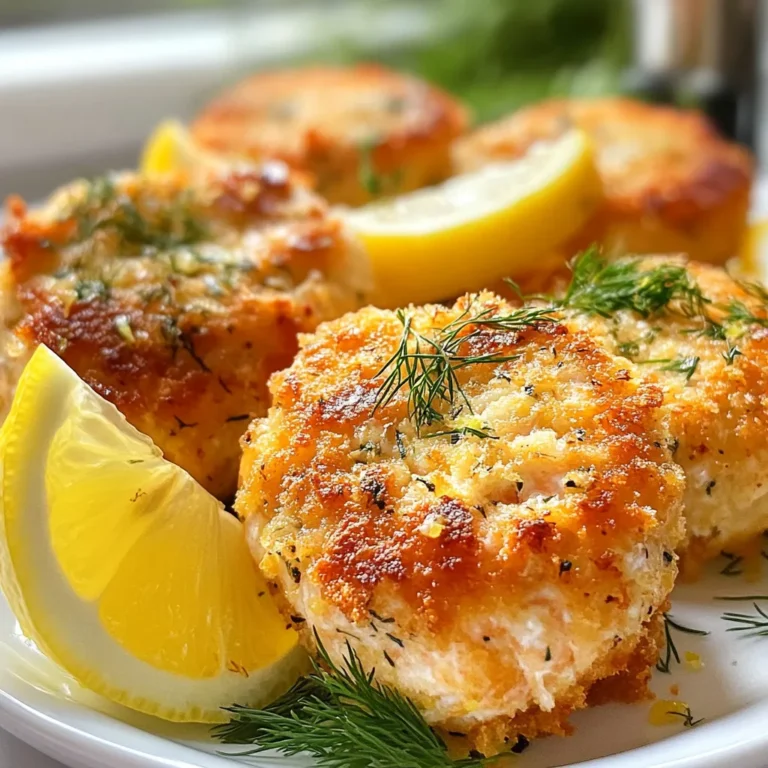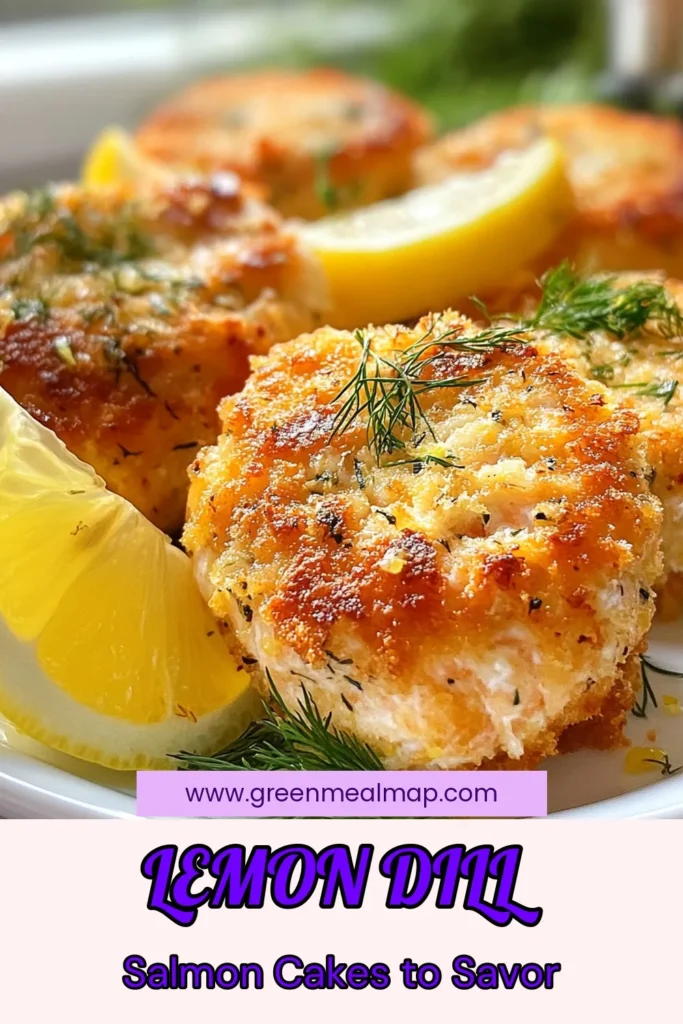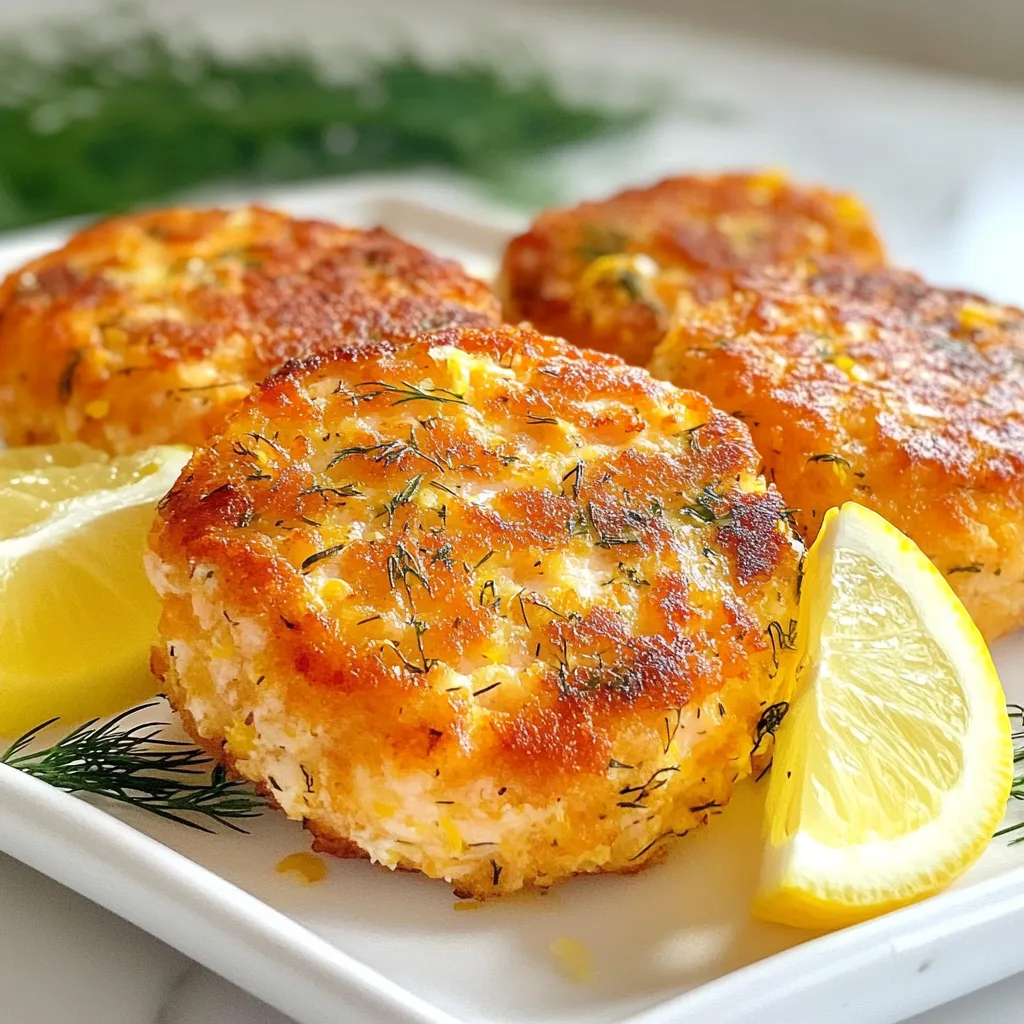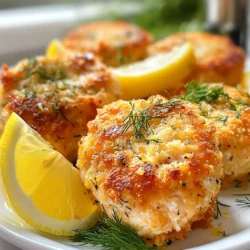WANT TO SAVE THIS RECIPE?
Welcome to my kitchen! Today, we’re making Lemon Dill Salmon Cakes—a dish that’s both tasty and quick. With fresh salmon fillets and a few key ingredients, you’ll impress your family at dinner. I’ll guide you through easy steps to perfect these savory cakes. From cooking tips to serving ideas, I have everything you need for this delightful meal. Let’s dive in and create something special!
Why I Love This Recipe
- Fresh and Flavorful: These salmon cakes are packed with fresh ingredients, ensuring a burst of flavor in every bite.
- Easy to Make: With simple steps and minimal prep time, these cakes are perfect for a quick weeknight dinner.
- Versatile Dish: They can be served as an appetizer, main course, or even as a snack, making them a flexible addition to any meal.
- Healthy Option: Rich in omega-3 fatty acids, these salmon cakes are not only delicious but also a nutritious choice for your diet.
Ingredients
Fresh Salmon Fillets
You need 1 pound of fresh salmon fillets. Use skinless fillets for best results. Fresh salmon has a bright flavor that shines in these cakes. Cooking it makes the salmon easy to flake.
Other Key Ingredients
– 1/2 cup breadcrumbs (panko or regular)
– 1/4 cup mayonnaise
– 1 large egg
– 2 tablespoons fresh dill, chopped
– 1 tablespoon lemon zest
– 2 tablespoons lemon juice
– 1 garlic clove, minced
– Salt and pepper to taste
– 2 tablespoons olive oil (for frying)
These ingredients create a balance of taste and texture. The breadcrumbs add crunch, while the mayonnaise keeps the cakes moist. Dill, lemon zest, and lemon juice bring bright flavors that match the salmon perfectly.
Optional Serving Suggestions
You can serve these cakes with a few simple sides. Fresh dill and lemon wedges make great garnishes. A dollop of tartar sauce or lemon dill yogurt sauce gives added flavor. Pair with a light salad or some steamed veggies for a full meal.

Step-by-Step Instructions
Cooking the Salmon
First, you need to cook the salmon. You can poach it in simmering water for about 10 minutes. This method keeps the fish tender. Alternatively, you can bake it in a preheated oven at 375°F (190°C) for about 15 minutes. It should be cooked through and flake easily with a fork. Once done, set it aside to cool.
Mixing the Ingredients
Now that your salmon is cool, flake it into small pieces in a large bowl. Add the following ingredients to the bowl:
– 1/2 cup breadcrumbs
– 1/4 cup mayonnaise
– 1 large egg
– 2 tablespoons fresh dill, chopped
– 1 tablespoon lemon zest
– 2 tablespoons lemon juice
– 1 garlic clove, minced
– Salt and pepper to taste
Mix everything together gently. Be careful not to overmix. You want to keep some texture in the mixture.
Forming the Patties
With your salmon mixture ready, it’s time to form the patties. Use your hands to scoop about a quarter cup of the mixture. Shape it into a patty that is about 2 inches wide. Place the patties on a plate. You should make about 8 cakes.
Frying the Cakes
Next, heat 2 tablespoons of olive oil in a large skillet over medium heat. Once the oil is hot, gently add the salmon cakes to the skillet. Cook them in batches if needed, so they don’t crowd the pan. Fry each cake for about 3 to 4 minutes on each side. They should turn golden brown and crispy. Once cooked, transfer the cakes to a paper towel-lined plate to soak up any extra oil.
Tips & Tricks
Ensuring Flavor and Texture
To get the best flavor in your salmon cakes, use fresh salmon. The taste is brighter and cleaner. I like to add fresh dill and lemon zest. They bring a bright taste that pairs well with salmon. You can also adjust salt and pepper to your liking. Be careful not to overmix the batter. This keeps a nice texture, which makes each bite delightful.
Cooking Techniques for Perfect Cakes
For cooking, you have two great options: poaching or baking. Poaching is quick and keeps the salmon moist. Just simmer it in water for about 10 minutes. Baking is easy, too! Set your oven to 375°F (190°C) and let it bake for about 15 minutes. Once cooked, use a fork to flake the salmon into small pieces. This makes it easier to mix.
When frying, heat the olive oil in a skillet on medium heat. Avoid overcrowding the pan; this helps each cake get crispy. Cook each side for about 3-4 minutes. You want them golden brown. After frying, put the cakes on a paper towel to soak up extra oil.
Presentation Ideas
Presentation makes your dish pop! I love to garnish with fresh dill and lemon wedges. This adds color and freshness. A dollop of tartar sauce or lemon dill yogurt sauce makes a lovely touch. It adds creaminess and flavor, making the meal even better. Serve the cakes warm for the best taste!
Pro Tips
- Use Fresh Salmon: Fresh salmon will yield the best flavor and texture for your cakes. If possible, avoid using frozen salmon for this recipe.
- Chill the Mixture: After mixing the ingredients, let the salmon mixture sit in the fridge for about 15-20 minutes. This helps the cakes hold their shape while cooking.
- Test Fry One Cake: Before frying all the patties, test one in the skillet to check for seasoning and to ensure the mixture holds together.
- Keep the Cakes Warm: If making in batches, keep the cooked salmon cakes warm in a 200°F (93°C) oven while you finish frying the rest.

Variations
Alternative Ingredients
You can change the main ingredient. Instead of fresh salmon, try canned salmon. Canned salmon can save time and still taste great. If you want a different flavor, use crab meat or shrimp. You can also swap dill for other herbs. Parsley or basil can give a fresh twist. For a gluten-free option, use gluten-free breadcrumbs. This keeps the cakes tasty for everyone.
Different Cooking Methods
Frying is not the only way to cook salmon cakes. You can bake them for a healthier option. Preheat your oven to 375°F and place the patties on a baking sheet. Bake for about 15-20 minutes until golden brown. Air frying is another great choice. Set the air fryer to 375°F and cook for about 10-12 minutes. Both methods keep the cakes light and fluffy.
Serving with Sauces and Sides
Pair your salmon cakes with tasty sauces. A lemon dill yogurt sauce adds a nice zing. Tartar sauce is a classic choice that works well too. For sides, consider a fresh salad or roasted veggies. A light quinoa dish can also complement the cakes. Add lemon wedges for a fresh squeeze right before eating. This enhances the flavor and makes each bite special.
Storage Info
Refrigeration Tips
After you make the lemon dill salmon cakes, let them cool. Place them in an airtight container. They will stay fresh in the fridge for about three days. To keep the cakes crispy, avoid stacking them. Instead, layer them with parchment paper in between.
Freezing Instructions
You can also freeze the salmon cakes for later use. First, let them cool completely. Then, place them on a baking sheet lined with parchment paper. Freeze for about two hours until firm. Once frozen, transfer them to a freezer-safe bag. They can last for up to three months in the freezer.
Reheating Method
To reheat your salmon cakes, you have a few options. For the best results, use a skillet. Heat a little olive oil over medium heat. Cook each cake for about 3 minutes on each side until warm. You can also use an oven. Preheat it to 375°F (190°C) and bake for about 10 minutes. If you choose the microwave, be aware they may lose some crispiness. Heat them in 30-second intervals until warm.
FAQs
Can I use canned salmon instead of fresh?
Yes, you can use canned salmon. Canned salmon is convenient and saves time. It works well in this recipe. Just drain the salmon before using it. You may want to adjust the salt since canned salmon often has added salt. Canned salmon may have a different texture, but it still tastes great.
How do I prevent salmon cakes from falling apart?
To keep your salmon cakes from falling apart, follow these tips:
– Use enough binder: The egg and mayonnaise help hold the mixture together.
– Don’t overmix: Stir gently to keep some texture. Overmixing can make the cakes mushy.
– Chill the patties: Refrigerate the formed cakes for about 30 minutes before cooking. This helps them firm up.
– Fry at the right heat: Use medium heat. Too hot can burn the outside while leaving the inside soft.
What can I serve with Lemon Dill Salmon Cakes?
Lemon Dill Salmon Cakes pair well with several sides:
– Salad: A light green salad with vinaigrette adds freshness.
– Rice: Flavored rice, like lemon or herb rice, complements the cakes.
– Vegetables: Roasted or steamed vegetables add color and nutrition.
– Sauces: Tartar sauce or a lemon dill yogurt sauce enhances flavor.
– Bread: Serve with crusty bread for a complete meal.
These sides balance the flavors and make a delightful meal.
You have learned how to make tasty lemon dill salmon cakes. We covered fresh salmon fillets and other key ingredients for great flavor. I shared steps for cooking, mixing, and frying. I also gave tips for texture and presentation ideas. Plus, we explored variations and how to store leftovers.
Now you can create delicious meals that impress. Enjoy making and sharing these salmon cakes with friends and famil
Lemon Dill Salmon Cakes
Delicious salmon cakes flavored with lemon and dill, perfect as an appetizer or main dish.
Prep Time 15 minutes mins
Cook Time 15 minutes mins
Total Time 30 minutes mins
Course Main Course
Cuisine American
Servings 4
Calories 300 kcal
- 1 lb fresh salmon fillets (skinless)
- 1/2 cup breadcrumbs (panko or regular)
- 1/4 cup mayonnaise
- 1 large egg
- 2 tablespoons fresh dill, chopped
- 1 tablespoon lemon zest
- 2 tablespoons lemon juice
- 1 clove garlic, minced
- to taste salt and pepper
- 2 tablespoons olive oil (for frying)
Begin by cooking the salmon. You can either poach it in simmering water for about 10 minutes, or bake it in a preheated oven at 375°F (190°C) until cooked through and easily flaked, which should take about 15 minutes.
Once the salmon is cooked and cooled, flake it into small pieces using a fork and place it into a large mixing bowl.
Add the breadcrumbs, mayonnaise, egg, dill, lemon zest, lemon juice, minced garlic, salt, and pepper to the bowl. Mix everything together gently until well combined. Ensure not to overmix, as you want to keep some texture.
Using your hands, form the mixture into patties about 2 inches in diameter, and place them on a plate. You should yield around 8 cakes.
Heat olive oil in a large skillet over medium heat. Once hot, carefully place the salmon cakes in the skillet, cooking in batches if necessary to avoid overcrowding.
Fry for about 3-4 minutes on each side, or until golden brown and crispy.
Once cooked, transfer the salmon cakes to a paper towel-lined plate to absorb any excess oil.
Serve garnished with fresh dill and lemon wedges. Consider adding tartar sauce or lemon dill yogurt sauce for extra flavor.
Keyword cakes, dill, lemon, salmon, seafood
WANT TO SAVE THIS RECIPE?





